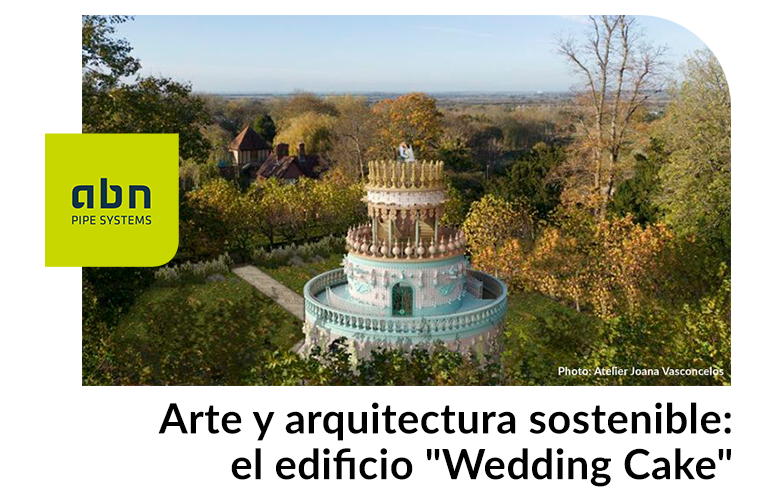La construcción y la arquitectura cada vez están más sensibilizados en cuanto al impacto que sus obras y diseños van a tener en el medio ambiente. Constantemente se dan a conocer nuevos ejemplos de construcciones que buscan reducir su huella ecológica.
Este es el caso de la “Wedding Cake”, un diseño enmarcado por unos jardines de ensueño que busca sorprender y deleitar a sus visitantes. Un gran ejemplo de construcción sostenible, por su respeto a los materiales tradicionales y a su modernidad, por el empleo de elementos que reducen cualquier impacto en el medio ambiente asociado a su disfrute.
La obra más dulce: la “Wedding Cake”
Casi cinco años se han necesitado para construir el edificio “Wedding Cake”, una obra nacida para albergar bodas, encargo de la Fundación Rothschild a la artista portuguesa Joana de Vasconcelos y que actualmente engalana la propiedad victoriana de Waddesdon Manor, situada a unos 80 kilómetros al noroeste de Londres.
“Esto es un edificio, pero es una escultura, un templo, un pastel de bodas. Es todo cerámica, tiene cuatro pisos de altura y de alguna manera es una pieza que tiene un lado constructivo, un lado arquitectónico y un lado de ingeniería” detalla la artista visual Joana Vasconcelos en una entrevista para el diario portugués Expresso50, sobre su innovadora construcción.
Esta obra se trata de un edificio con forma de tarta nupcial de unas 52 toneladas de peso y 12 metros de altura completamente revestidos con azulejos de cerámica portuguesa, de la fábrica Viúva Lamego, y lleno de oníricas figuras, que busca ser un lugar de ensueño para decir el “sí, quiero”.
Cada piso tiene un color diferente: el primer piso es verde, el segundo piso es azul, el tercer piso es rosa y el último piso es amarillo. Y el interior está decorado con estatuas de San Antonio, una referencia a las bodas que se espera que tengan lugar en el espacio. En la planta superior, dos escaleras paralelas permiten que los novios lleguen a la cima al mismo tiempo, simulando el tradicional adorno cerámico de las tartas nupciales.
Un proyecto de conciencia y recuperación
El compromiso sostenible de este proyecto comienza desde su planteamiento. Uno de sus fines fue la recuperación de moldes y la reproducción de piezas decorativas para edificios y fachadas de edificios comunes de Lisboa de principios del siglo XX. Para ello, la artista indagó en la historia de la empresa de cerámica portuguesa fundada en 1849, para rehabilitar piezas que según su autora “forman, de alguna manera, parte del imaginario colectivo y de la historia y la tradición”, entre las que se incluyen sirenas, delfines, velas, fuentes y querubines.
El gran número de materiales empleados en la obra, destacan su importancia y valor arquitectónico: 3.500 piezas de hierro forjado, 21.815 kg de chapa de hierro, 25.150 azulejos de cerámica (de 99 tipos diferentes) y 1.238 piezas de cerámica (de 52 tipos diferentes), todas ellas producidas en Portugal y desmontadas para ser transportadas a Inglaterra.
Esta labor de restauración de materiales cobra gran valor cuando hablamos de economía circular, ya que, en gran medida, además de haber sido reciclados y reutilizados, este nuevo uso contribuye a ganar en eficiencia y sostenibilidad.
Adicionalmente, para su red de evacuación de aguas se han empleado materiales respetuosos con el medio ambiente como son las tuberías de polipropileno, que entre sus propiedades destacan:
- La eficiencia energética en su fabricación: requieren menos energía en comparación son sus sustitutivos.
- Una menor emisión de CO2 en su transporte: se trata de un material liviano, lo cual minimiza la energía para su transporte.
- Una larga vida útil: son conocidas por su durabilidad y resistencia a la corrosión.
- Un fácil reciclado: se puede emplear para producir nuevos productos.
La importancia de las tuberías insonorizadas en obras de diseño públicas
Para este tipo de construcciones se debe considerar que su sistema de tuberías de evacuación esté perfectamente insonorizado para evitar ruidos desagradables que afecten al curso normal de su actividad.
Para ello, las tuberías de polipropileno logran una mayor reducción del ruido en paredes de un espesor inferior. Además, también cuentan con características que hacen de estas la mejor opción para la arquitectura de diseño:
- Reducen los ruidos que se desprenden de los elementos estructurales de la edificación.
- Tienen gran versatilidad gracias a que es un material resistente, flexible e impermeable.
- Cuentan con una muy baja emisión de humos y no son tóxicas.
- Son resistentes a altas y bajas temperaturas (de -20º a 95º).
- Previenen incrustaciones y garantizan un caudal constante gracias a su capa interna extremadamente lisa.
- Son ecológicas y reciclables.
